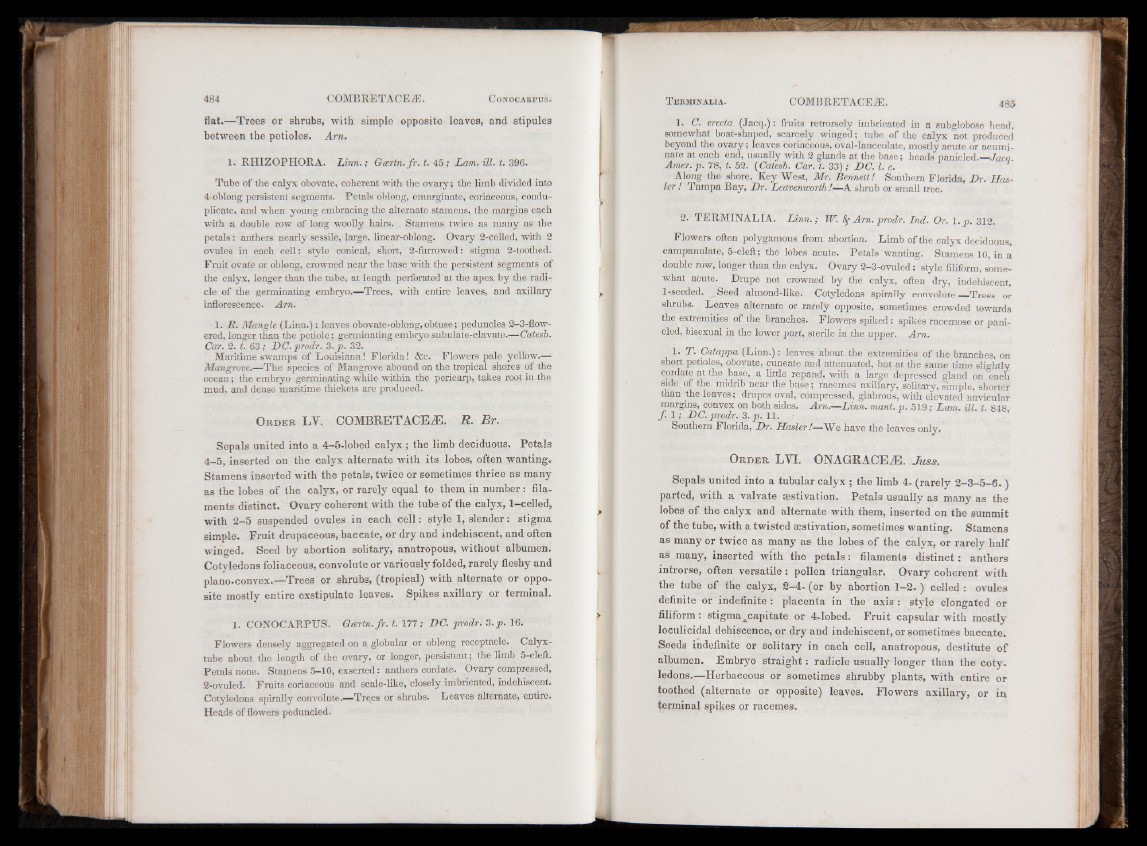
flat.—Trees or shrubs, with simple opposite leaves, and stipules
between the petioles. A m .
1. RHIZOPHORA. Linn.; Geertn.fr. t. 45; Lam. ill. t. 396.
Tube of the calyx obovate, coherent with the ovary; the limb divided into
4 oblong persistent segments. Petals oblong, emarginate, coriaceous, eondu-
plicate, and when young embracing the alternate stamens, the margins each
with a double row of long woolly hairs. Stamens twice as many as the
petals: anthers nearly sessile, large, linear-oblong. Ovary 2-celled, with 2
ovules in each cell: style conical, short, 2-fhrrowed: stigma 2-toothed.
Fruit ovate or oblong, crowned near the base with the persistent segments of
the calyx, longer than the tube, at length perforated at the apex by the radicle
of the germinating embryo.—Trees, with entire leaves, and axillary
inflorescence. Am.
1. R. Mangle (Linn.) : leaves obovate-oblong, obtuse; peduncles 2-3-flow-
ered, longer than the petiole; germinating embryo subulate-clavate.—Catesb.
Car. 2. t. 63; DC. prodr. 3. p. 32.
Maritime swamps of Louisiana! Florida! &e. Flowers pale yellow.—
Mangrove.—The species of Mangrove abound on the tropical shores of the
ocean; the embryo germinating while within the pericarp, takes root in the
mud, and dense maritime thickets are produced.
Or d e r LY. COMBRETACEiE. R. Br.
Sepals united into a 4-5-lobed calyx,; the limb deciduous. Petals
4-5, inserted on the calyx alternate with its lobes, often wanting.
Stamens inserted with the petals, twice or sometimes thrice as many
as the lobes of the calyx, or rarely equal to them in number: filaments
distinct. Ovary coherent with the tube of the calyx, 1-celled,
with 2 -5 suspended ovules in each c e ll: style 1, slender: stigma
simple. Fruit drupaceous, baccate, or dry and indehiscent, and often
winged. Seed by abortion solitary, anatropous, without albumen.
Cotyledons foliaceous, convolute or variously folded, rarely fleshy and
plano-convex.—Trees or shrubs, (tropical) with alternate or oppo-
site mostly entire exstipulate leaves. Spikes axillary or terminal,
1. CONOCARPUS. Geertn.fr. t. 177; DC. prodr. 3. p. 16.
Flowers densely aggregated on a globular or oblong receptacle. Calyx-
tube about the length of the ovary, or longer, persistent; the limb 5-cleft.
Petals none. Stamens 5-10, exserted: anthers cordate. Ovary compressed,
2-ovuled. Fruits coriaceous and scale-like, closely imbricated, indehiscent.
Cotyledons spirally convolute.—Treves or shrubs. Leaves alternate, entire.
Heads of flowers peduncled.
1. C. erecta (Jacq.): fruits retrorsely imbricated in a subglobose head,
somewhat boat-shaped, scarcely winged; tube of the calyx not produced
beyond the ovary; leaves coriaceous, oval-lanceolate, mostly acute or acuminate
at each end, usually with 2 glands at the base; heads panicled.__Jaca.
Amer.p. 78, t. 52. (Catesb. Car. t. 33); DC. 1. c.
Along the shore, Key West, Mr. Bennett! Southern Florida, Dr. Hosier!
Tampa Bay, Dr. Leavenworth!—A shrub or small tree.
2. TERMINALLY. Linn.; W. 8f Am.prodr. Ind. Or. l.y>. 312.
Flowers often polygamous from abortion. Limb of the calyx deciduous,
campanulate, 5-cleft; the lobes acute. Petals wanting. Stamens 10, in a
double row, longer than the calyx. Ovary 2-3-ovuled: style filiform, somewhat
acute. Drupe not crowned by the calyx, often dry, indehiscent,
1-seeded. ^ Seed almond-like. Cotyledons spirally convolute.__Trees or
shrubs. Leaves alternate or rarery opposite, sometimes crowded towards
the extremities of the branches. Flowers spiked: spikes racemose or panicled,
bisexual in the lower part, sterile in the upper. Am.
1. T. Catappa (Linn.): leaves about the extremities of the branches, on
short petioles, obovate, cuneate and attenuated, but at the same time slightly
cordate at the base, a little repand, with a large depressed gland on each
side of the midrib near the base; racemes axillary, solitary, simple, shorter
than the leaves; drupes oval, compressed, glabrous, with elevated navicular
margins, convex on both sides. Am .—Linn. mant. p. 519; Lam. ill. t. 848.
ƒ. 1 ; DC. prodr. 3. p . 11.
Southern Florida, Dr. Hosier!— We have the leaves only.
Or d e r LYI. ONAGRACEiE. J u s s .
Sepals united into a tubular calyx ; the limb 4- (rarely 2 -3 -5 -6 - )
parted, with a valvate aestivation. Petals usually as many as the
lobes of the calyx and alternate with them, inserted on the summit
o f the tube, with a twisted aestivation, sometimes wanting. Stamens
as many or twice as many as the lobes o f the calyx, or rarely half
as many, inserted with the p e ta ls : filaments d is tin c t: anthers
introrse, often v e rsa tile : pollen triangular. Ovary coherent with
the tube of the calyx, 2-4- (or by abortion 1-2- ) celled : ovules
definite or indefinite : placenta in the axis : style elongated or
filiform: stigma^capitate or 4-lobed. F ru it capsular with mostly
loculicidal dehiscence, or dry and indehiscent, or sometimes baccate.
Seeds indefinite or solitary in each cell, anatropous, destitute o f
albumen. Embryo s tr a ig h t: radicle usually longer than the coty.
ledons.—Herbaceous or sometimes shrubby plants, with entire or
toothed (alternate or opposite) leaves. Flowers axillary, or in
terminal spikes or racemes.